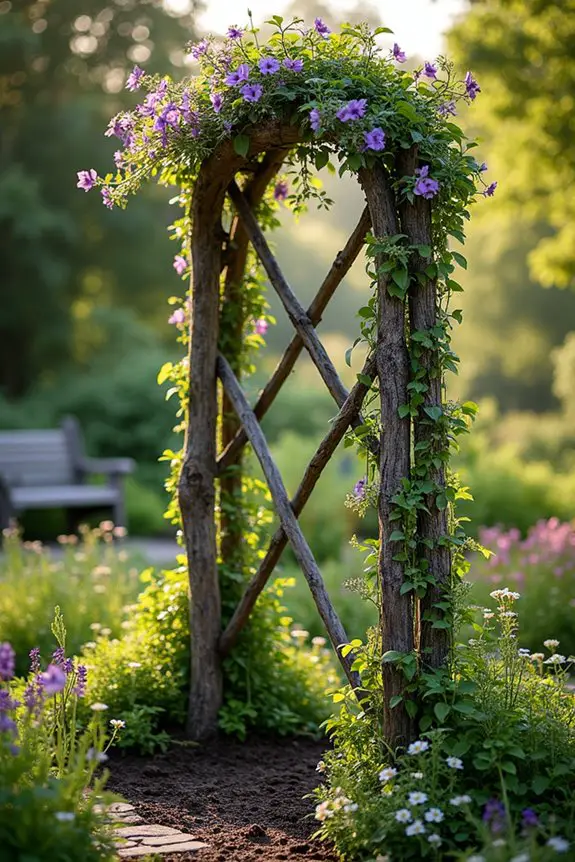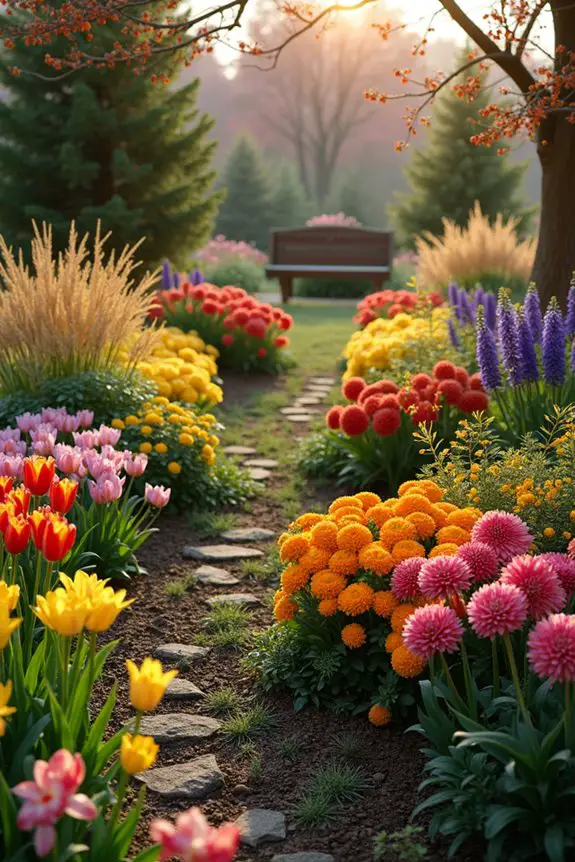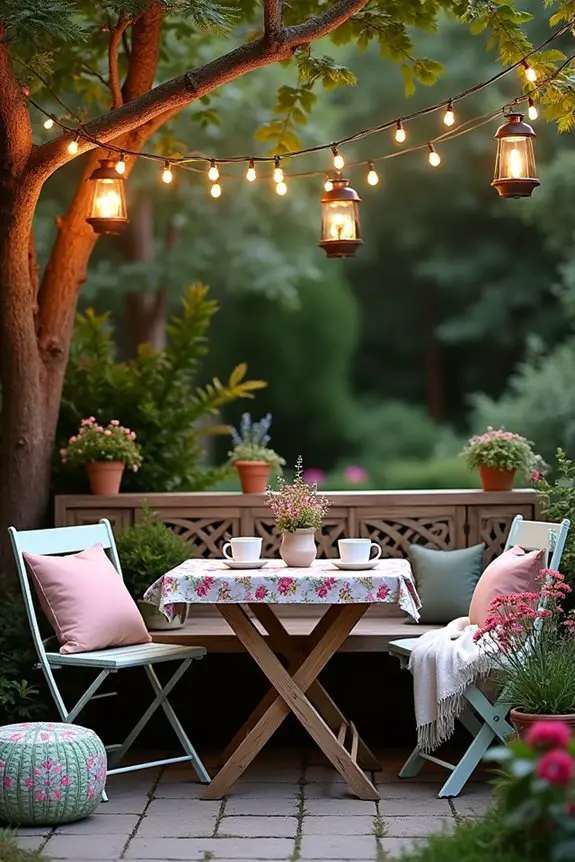Think of a garden trellis as the backbone of your outdoor space, supporting not just plants, but your dreams of a beautiful sanctuary. You might wonder how to blend functionality with artistry, or maybe you’re picturing a massive DIY project you’ll never finish (trust me, I’ve been there). But it doesn’t have to be overwhelming. With a bit of creativity and some clever designs, you can transform your garden into something special. Ready to explore?
Living Tree Branch Trellis
Have you ever thought about using tree branches to create a living trellis in your garden?
It’s not just practical but gives your outdoor space a cozy, organic feel. By intertwining climbing plants with young trees, you’ll blend nature and structure beautifully, making every corner of your garden come alive.
1. Organic Wooden Frame Structure
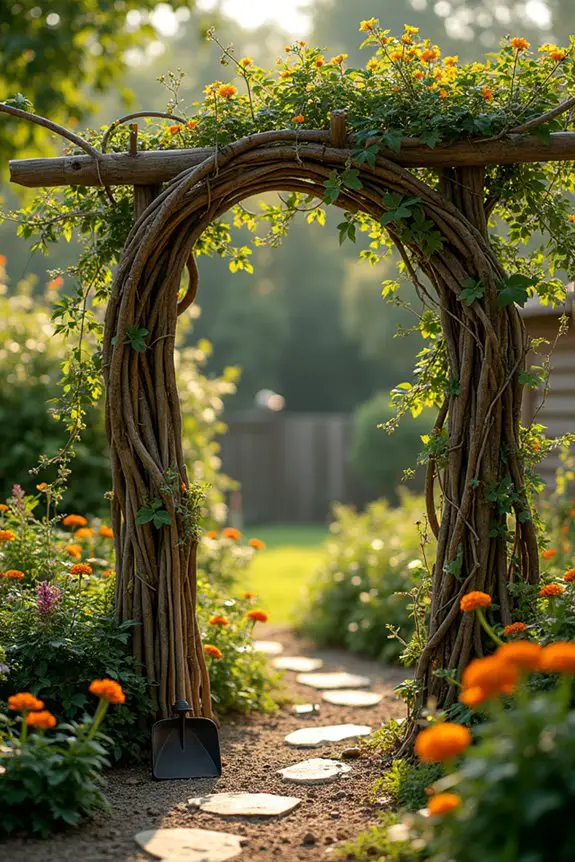
Creating a garden trellis using tree branches isn’t only functional, but it also brings a whimsical touch to your outdoor space. Envision a delightful tangle of climbing plants, effortlessly intertwined with young trees or branches, creating a scene straight out of a fairytale. This living trellis idea supports healthy plant growth, while blending the beauty of nature right into your garden. It’s organic, charming, and oh-so-inviting. Additionally, a well-constructed garden gate arch arbor can serve as a stunning focal point as your plants flourish.
So, how do you get started? First, gather some sturdy, young branches—think of them as the backbone of your project. You can either prune some from your existing trees or get creative and visit your local garden center.
Next, find some climbing plants that won’t only thrive but also look stunning against the wood. Vines like honeysuckle or clematis work wonders, wrapping around those branches like a warm hug.
Once you have your materials ready, it’s time to play architect. Envision this: lean those branches at various angles to form a natural lattice. You can even intertwine them for a more rustic feel. Don’t worry about getting it perfect; nature thrives on a little chaos.
Secure everything with twine or wire, as this will help hold those branches in place while your plants start to do their thing. An essential tool you might consider for maintaining this enchanting setup is a hand rake small garden to help keep the base tidy and promote healthy growth.
As your climbing plants begin their vertical journey, you’ll find it transforms your garden into a lush paradise. Trust me, watching those greens creep up and around your living trellis is like a mini-experience of magic unfolding in your backyard.
And let’s face it, who doesn’t want a little enchantment in their life, right?
2. Tree Branch Integration
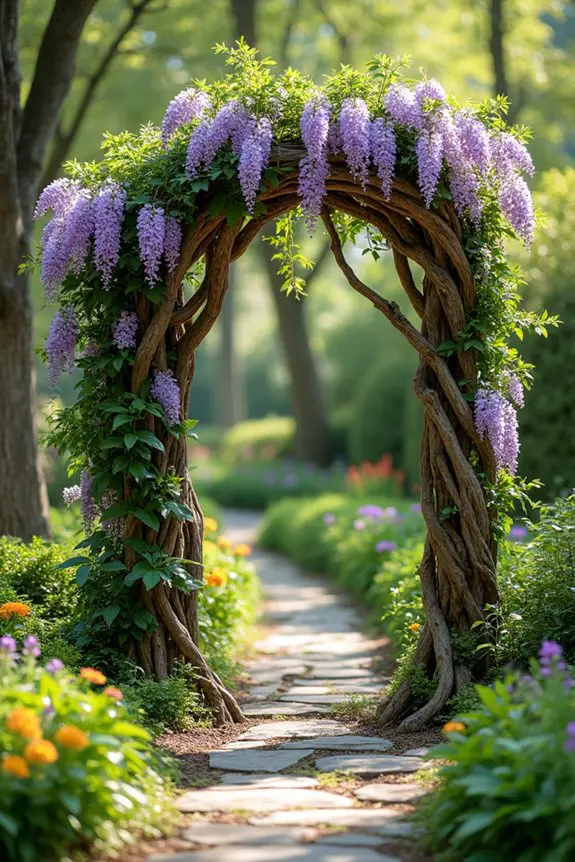
Integrating tree branches into your garden trellis isn’t just about support; it’s a delightful way to create a living sculpture that whispers “nature’s touch” in every corner of your garden.
Imagine strolling by a graceful blend of plants and wood, where the bond between them enhances both functionality and aesthetic appeal. Plus, it’s like giving your plants a cozy home with a bit of flair.
What’s great about tree branch integration is how simple it can be. First, select branches that are strong yet flexible—you’ll want them to withstand the wind while welcoming those climbing beauties.
Whether you raid your garden or scavenge the park, keep an eye out for the perfect specimens. Then, take those branches and position them cleverly around your climbing plants. Lean them at different angles, overlap them a bit; it’s that whimsical chaos that makes it enchanting.
And don’t stress if it doesn’t look like a magazine cover right away. Nature has a rejuvenating way of making things beautiful, even at their most unconventional.
As for those climbing plants, consider your options. Vines like wisteria or ivy can spin a marvelous tale around those branches, transforming the ordinary into the extraordinary.
You might even catch yourself feeling like a garden wizard as you watch your greens twirl around the branches, creating a tapestry that changes with the seasons. Just remember to secure everything well—nothing’s more embarrassing than your delicate vibe collapsing with a gust of wind.
Branch out in your outdoor escapades with this tree branch integration, and always keep a little wonder in your heart as your garden grows.
Why settle for a typical trellis when you can have a dynamic, living piece of art right in your yard?
3. Natural Aesthetic Integration
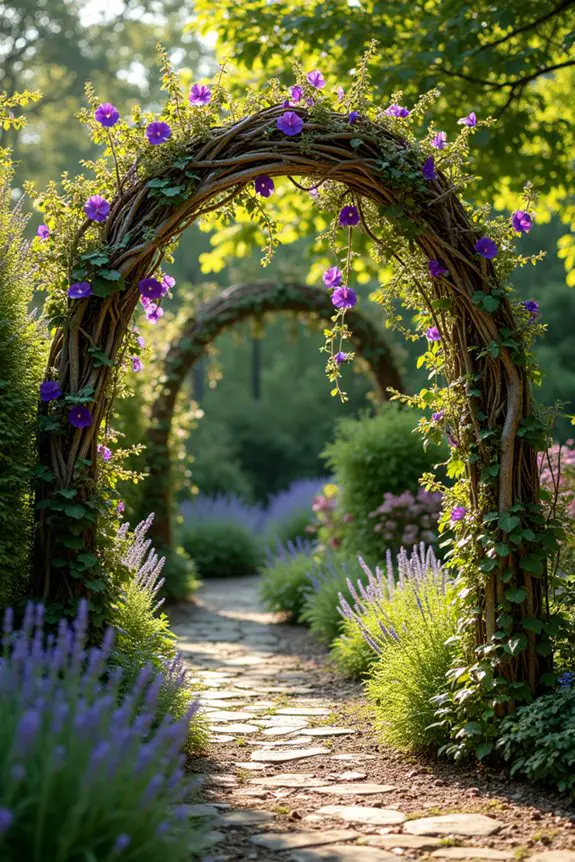
When it comes to adding a touch of organic charm to your outdoor space, nothing beats the beauty of a Natural Aesthetic Integration. Imagine a living tree branch trellis that not only supports your climbing plants but also weaves together nature’s artistry with a cozy ambiance. It’s like inviting your garden to throw a celebratory party, and who doesn’t want a front-row seat to that?
First things first, choose branches that blend with the flora around you—some sturdy, some delicately whimsical. Picture those gnarled, ancient branches with tales to tell, mingling with vibrant vines like morning glory or honeysuckle. They complement each other beautifully, creating a visual feast that’s pure wow.
Now, securing those branches can feel a bit like rigging a circus tent, and I get it; it can be a balancing act. Use twine or even some sturdy wire to wrap your climbing plants around those branches, letting nature do its magic as they twist and grow. You’ll soon find your backyard transformed into a secret wonderland, where every angle reveals a new layer of greenery.
Don’t stress if your masterpiece isn’t picture-perfect at first—gardens are genuinely forgiving. We’re all in a constant remix of growth, after all. I once attached a particularly stubborn vine that decided it preferred the neighbor’s side – classic.
But over time, it found its way back home, and that’s the enchanting part. The garden will develop its character, and you’ll find joy in those little quirks. Additionally, a stunning wisteria trellis can create a captivating focal point that enhances the beauty of your climbing plants.
4. Tree Branch Integration Technique
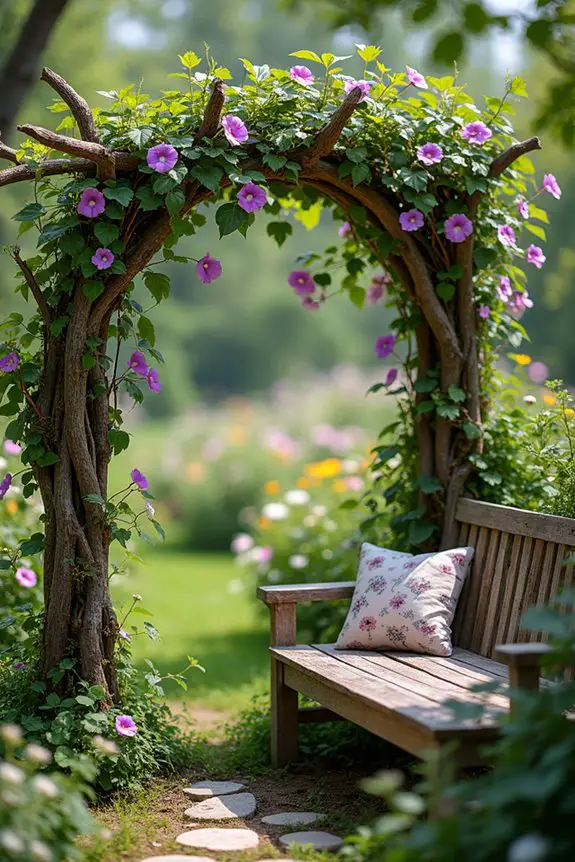
When it comes to integrating tree branches into your garden, the Living Trellis Using Tree Branches technique is a game-changer. This method not only supports your climbing plants but also gives your garden a whimsical, organic vibe that feels straight out of a fairy tale. Just imagine those branches weaving together with lush vines, creating a natural tapestry that draws the eye and invites a sense of wonder.
Start by selecting branches that feel right for your space. Aim for a mix of strength and charm—think stout limbs that can take a beating but still have character, like an old tree with stories to tell. You can grab some longer branches to create that vertical interest, while smaller twigs can add detail and texture. You could almost say it’s like building a mini forest right in your backyard.
Now, securing those branches is where the fun begins. Grab some sturdy twine or wire and start intertwining your climbing plants—those beauties like peas or morning glory are perfect for this. It’s a bit like teaching your plants how to dance; they’ll take their time to learn the steps. Don’t be surprised if they try to wiggle away at first; patience is key. I once spent an hour trying to convince a vine to stick around, only to find it had decided that the bird feeder was the place to be. Classic garden drama.
Once everything is set up, just sit back and enjoy the transformation. Your garden will take on a character of its own, growing and shifting with the seasons. Over time, those vines and branches will create a lush haven, and the quirky imperfections will give it that lived-in charm we all adore.
It’s a labor of love, truly—like nurturing a pet that occasionally thinks it can take a detour to the neighbor’s yard. But the joy of watching it flourish makes it all worth it.
5. Wooden Frame Construction Technique
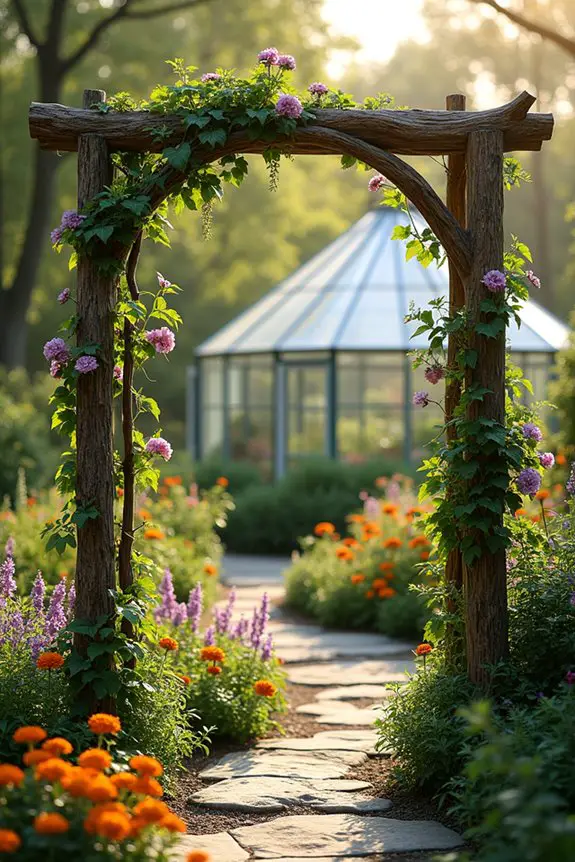
When it comes to creating a stunning display with a Living Tree Branch Trellis, the Wooden Frame Construction Technique is pure genius. It not only provides sturdy support for your climbing plants but also adds a rustic, warm touch to your garden—like a cozy hug from Mother Nature herself. Plus, who wouldn’t want a whimsical structure that feels both functional and artistic? A walk-in greenhouse can serve as a perfect companion to your trellis, allowing you to extend your growing season.
To begin, gather those beautiful branches you’ve already handpicked. Aim for ones that boast strength along with some character. Think about using thicker branches for the vertical posts that will stand tall and proud, and then choose some slender ones for the horizontal beams that will add that lovely frame-like effect. It’s a bit like constructing a tiny castle for your vines—a majestic abode that invites climbing and flourishing.
Once you have your branches sorted, it’s time to channel your inner carpenter. Cut them to size—nothing too fancy, just enough to create a frame that’s snug and secure, yet still leaves a little room for those rambunctious plants to roam. If your cutting skills feel a little shaky, don’t worry. My first attempt turned into an accidental scene from lumberjack bloopers. Precision isn’t the name of the game here; it’s about embracing the natural shapes your branches present.
Now, gather some strong twine or wire to bring it all together—think of it as crafting a hug for your frame. Use this trusty material to tie the intersections where your branches connect. Go ahead, get in there and wrap it like you mean it. Just remember, your plants will be relying on this structure, so don’t skimp on the support. When I built mine, I thought I could get away with a loose knot, only to have it wobble like a piñata at a kids’ birthday party. Not the most reliable setup for climbing plants.
After your frame is secured, start weaving in your climbing plants. This part feels like matchmaking, guiding those vines around your new wooden treasure. They might need a gentle nudge to find the right direction, and trust me, patience is key. It can feel like teaching a toddler how to share—sometimes they dig their heels in. But before you know it, they’ll start climbing, and it’s a magical sight watching those vines twirl around your creation.
With your wooden frame set and your plants happily attached, give yourself a well-deserved pat on the back. What’s left is to savor the transformation; over time, you’ll have a flourishing display that tells the story of your garden and invites birds and butterflies to join in the fun. Don’t forget to keep your garden scissors handy for precise trimming, as essential garden scissors can make maintaining your trellis and plants much easier.
It may take a little while to reach that dreamy, fairy-tale look, but isn’t that part of the adventure? Enjoy the journey—each day brings something new in your delightful outdoor space.
6. Tree Branch Weaving Method
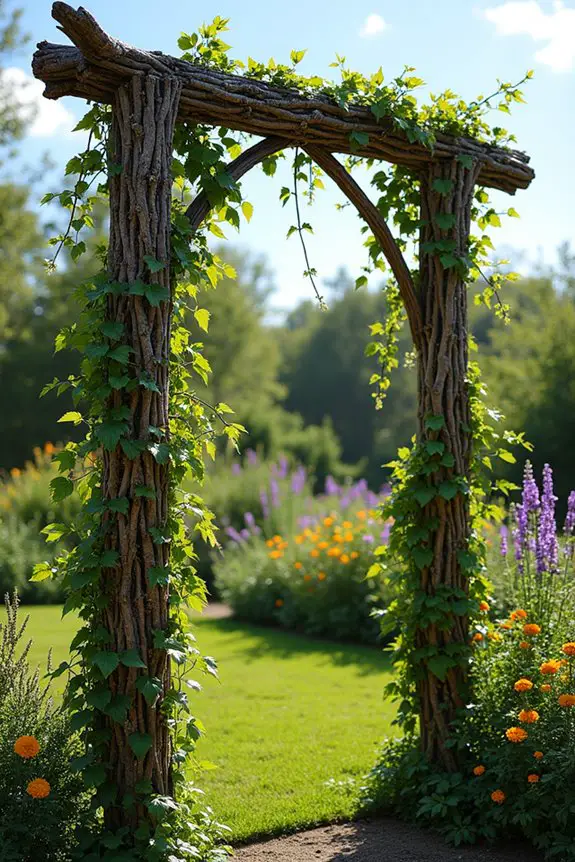
When it comes to creating a Living Tree Branch Trellis, the Tree Branch Weaving Method is like weaving magic into your garden. It’s not only functional, offering your climbing plants a unique playground, but it also gives off a rustic charm that feels like nature’s own artistry has come to life right in your backyard.
Imagine your vines happily twirling around a structure made of branches, creating a blissful, green haven for your outdoor space.
To start this project, you’ll first need a selection of supple yet sturdy branches, preferably those that like to bend a little but still have some strength in them. Think of these as your favorite spaghetti—they need to be flexible but not overcooked.
You’ll want to separate the branches into what’ll become vertical posts and a bunch of horizontal ones that will serve as your weaving material. It’s a little like quilting with nature; you’re creating beautiful patterns using what you have on hand.
Now, let’s plunge into the weaving part. Lay out the vertical branches first, making sure they’re securely anchored into the ground—you could even use some rocks or soil if they’re feeling wobbly.
Next, begin weaving those horizontal branches through the vertical ones in a crisscross pattern. This is where the magic happens. It can feel a bit like trying to untangle a ball of yarn, but remember, it’s not about perfection. In fact, the imperfect nature adds to the charm.
Although it sounds simple, there was this one time when I thought it would be clever to layer on an extra horizontal branch without properly tying it down. Let’s just say, it turned into a dramatic balcony for my local squirrels.
Oh, how they loved that little mishap! So, take your time, confirm everything is snug, and don’t hesitate to add a little twine or wire for extra support if things start feeling a bit loose.
Once you’ve finished weaving, step back and admire your artistry. Those climbing plants will soon be exploring their new abode, wrapping themselves around your woven masterpiece.
It’s almost like watching a magic show as your garden goes from bare to boisterously beautiful. So, grab those branches, channel your inner gardener, and let nature take the lead—your garden will thank you for it.
7. Branch Weaving Technique
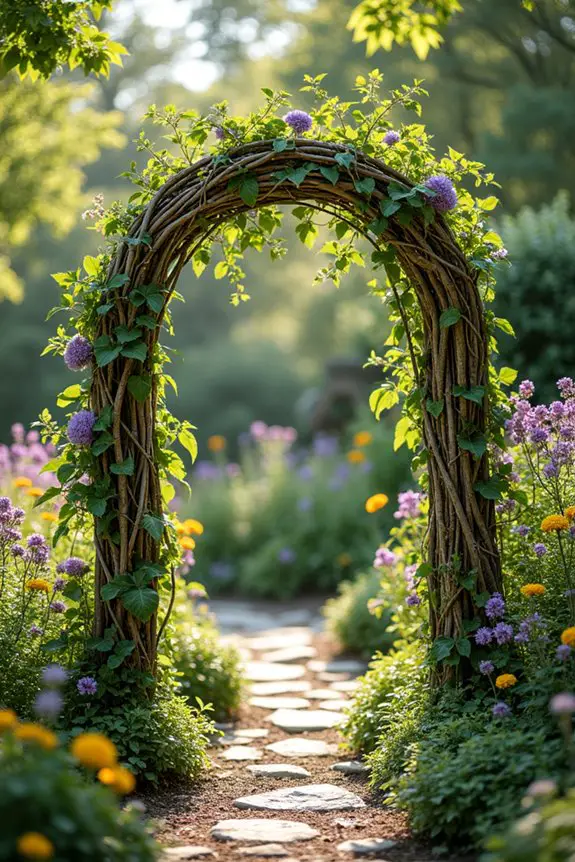
When crafting your Living Tree Branch Trellis, utilizing the Branch Weaving Technique can reveal a whole new level of creativity while giving your climbing plants a sturdy base to flourish. It not only supports your beloved vines but weaves in a rustic charm that’s straight out of a fairy tale garden. Picture those lush green tendrils gracefully dancing up your handmade structure—talk about a cozy atmosphere without lifting a finger to build from scratch.
Start by selecting your branches thoughtfully. You’ll want those flexible, bendable ones that can hold their own without being too cranky. Think of them as the perfect sidekick in your gardening adventure—strong but amiable. Aim for a mix of vertical posts that stand tall and proud and horizontal ones that get to do the fun weaving part.
Laying them out is like setting the stage for a beautiful performance; it’s all about balance and leading your plants to stardom. Once you’ve marked your ground with those vertical posts, it’s time to delve into the weaving. Maybe channel your inner artist and pretend you’re creating a mesmerizing masterpiece. Tie down those verticals firmly; you don’t want your trellis to wobble like a toddler on a sugar high.
Now, the horizontal branches come into play—crisscross them like a fun puzzle. Turn your trellis into an adventure for climbing plants that want to explore, wrap, and envelop their new home. Did I mention that this step can be a little chaotic? I remember one time getting way too excited and trying to slip in an extra branch. Let’s just say I ended up with a structure that looked more like a creepy spider web rather than a charming garden accent.
Our furry friends were thrilled, though—turning my garden into their new playground. So really, less is more. Make sure everything is snug and secure. If it starts to wobble, whisper sweet nothings and tie it down with twine or wire for added strength.
Finally, when your masterpiece is complete, step back and soak it all in. That tangled mess of vines will soon spring to life, swerving and twirling around your trellis like it’s preparing for a dance-off. Embrace the wild nature of it all, and of course—do not underestimate the satisfaction of creating a beautiful, functional piece of art for your space.
It’s a labor of love that turns your garden into a magical retreat. So, grab those branches, get a little messy, and let nature work its wonders. Your outdoor space will thank you for it.
8. Branch Weaving Artistry

When it comes to crafting a Living Tree Branch Trellis, embracing the artistry of branch weaving adds both flair and function to your garden. Think of it as giving nature a stylish outfit—one that not only looks great but also supports your climbing plants in their quest for the sun. This technique turns an ordinary trellis into a whimsical, organic structure that enhances your garden’s charm while helping plants climb higher toward the sky.
Start by gathering branches that aren’t just sturdy but also flexible. You want them to be like that reliable friend who’s always up for a new adventure—strong enough to hold up your plants but bendy enough to weave through without a fuss. Lay your vertical posts first, making them stand tall and proud, anchoring your trellis with confidence.
Then, it’s time to get artistic. Grab those horizontal branches and let your creative juices flow. Weave them in like you’re braiding hair, crisscrossing and looping to create a pattern that’s both functional and aesthetically pleasing.
Now, let me remind you—this part can get a little messy. Picture me once, tangled in a jumble of branches, convinced I was creating a masterpiece while actually resembling a rustic scarecrow. But each twisted branch turned into a delightful ineffable charm that made my garden feel like an enchanted forest.
So, remember: keep it neat but don’t be afraid of a little chaos. Tie those branches securely, but with a light touch; you’re crafting a trellis, not anchoring a ship.
Once your structure is solid, step back and behold your handiwork. That beautiful weave of nature will soon become a playground for climbing plants, inviting them to explore every nook and cranny like kids on a jungle gym. There’s something utterly satisfying about watching those vines twist and twirl around your creation, transforming it into a living piece of art.
9. Natural Woodsy Aesthetic
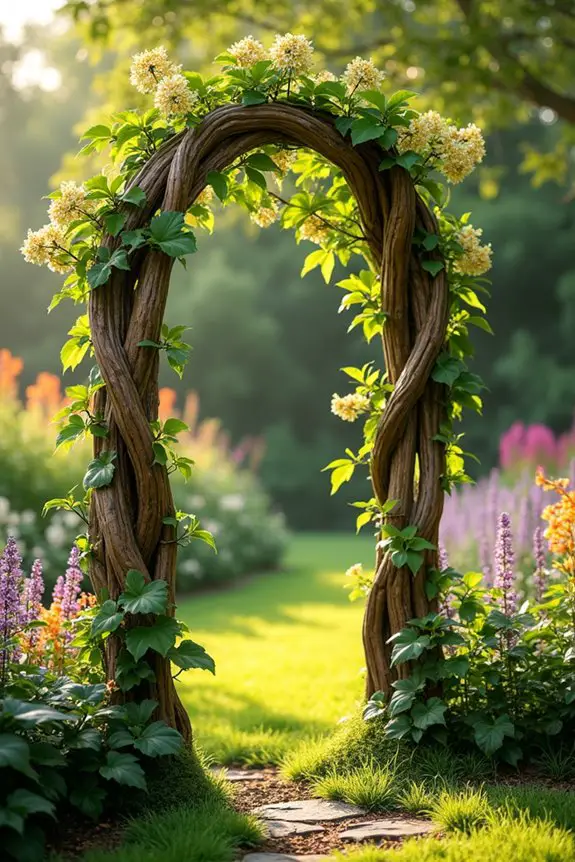
When you think of a Living Tree Branch Trellis, envision blending nature’s raw beauty with the functionality of a cozy garden nook. It’s like dressing up a plain piece of land with a charming accessory that supports your climbing plants while making your outdoor space look inviting and playful. Plus, who doesn’t love the idea of a trellis that’s both sturdy and uniquely yours?
One of the best features of this natural beauty is its woodsy aesthetic. Picture this: cool branches arching gracefully, adorned with vibrant greens as your beloved climbing plants wrap around them. They create a rustic vibe that feels like an enchanted forest, charming and a little wild all at once.
And that’s just the style boost. Functionally, these branches provide the perfect support for your plants to reach for the sky, literally.
To start your project, gather branches that aren’t only sturdy enough to hold up your plants but also flexible enough to weave together without resistance. Aim for a size that feels comfortable to you—think of it like choosing a cozy jacket. You want a snug fit, but not too snug.
As you lay out your vertical posts, be sure to plant them securely in your soil; after all, we want our trellis to stand tall and proud, ready for action.
Then comes the fun part: weaving those horizontal branches. I found this part both thrilling and slightly chaotic—like an art class gone rogue. But hey, that’s half the fun, right? Crisscross your branches, tie them in place, and don’t be afraid to let your creativity take the lead.
Just remember, the more loops and twists, the more character your trellis will have. And if you end up looking like a tangled mess yourself (been there), just laugh it off—your garden will thank you later.
Finally, take a step back and enjoy the view. Watch as your climbing plants begin to embrace the structure, creating a dynamic, living piece of art. Every twist and turn of those vines will be a reminder of your crafty handiwork, transforming your garden into something magical and vibrant.
10. Organic Framework Construction
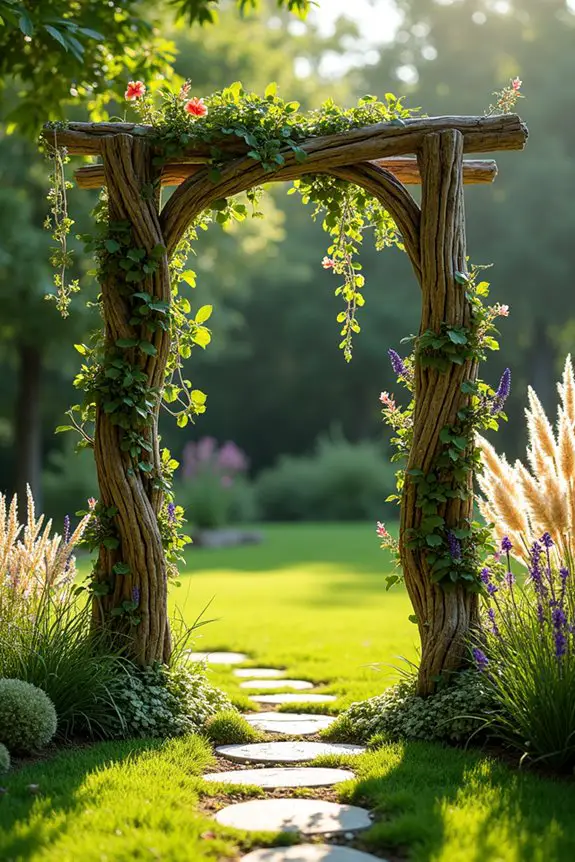
So, you’ve built a stunning Living Tree Branch Trellis; let’s chat about how to enhance its organic charm even further. The crux of any trellis project lies in building a solid framework. Not only does this provide essential support for your climbing plants, but it also creates that enchanting, nature-infused vibe we all adore. Imagine your garden as a cozy sanctuary where visitors feel tucked away in a whimsical woodland.
First things first, you’ll want to scout out some branches. Before heading out, take a moment to think about the aesthetic you’re going for. Are you envisioning something rustic and wild or more polished and slick? The branches you choose will greatly influence this vibe. Opt for a mix of thicker, sturdy branches for the main support while keeping lighter, more flexible ones for weaving. Trust me, size matters when it comes to figuring out what’ll hold up your future climbing beauties.
Once you’ve gathered your branches, it’s go-time. Place the sturdier branches in the ground like upright soldiers, standing firmly in their posts. Make sure they’re nice and deep—like burying a secret recipe card for safe keeping! A good rule of thumb is to ascertain they’re at least a couple of feet in the ground. You wouldn’t want your trellis to topple over at the first gust of wind, right? Nope, let’s avoid that embarrassment.
Now it’s time to weave those flexible branches into a charming organic design. Picture yourself tying those horizontal pieces together—a bit like crafting a delicious pasta dish, where everything just needs to come together in perfect harmony. Start from the bottom, bringing those branches across the supports in a crisscross pattern. It can get a little tricky, kind of like trying to braid your hair while watching a movie. But hey, take your time. Be a bit messy if you need to; after all, nature itself isn’t always neat and tidy.
After a good interlace, secure everything with twine or garden wire. Think of it as hugging your framework tightly, giving it the love it deserves. You want to create a sturdy canvas that your climbing plants can’t resist wrapping around. With every loop, imagine how lush and vibrant your garden will feel when those vines finally take off. It’s like a grown-up version of waiting for the cookies to bake—anticipation at its finest.
Finally, give yourself a pat on the back! Stand back and admire your handiwork. Visualize those climbing plants wrapping themselves around your organic trellis, transforming it into a living gallery of colors, textures, and fragrances. Trust in the process and watch as your little outdoor nook evolves into a cozy escape that feels just like home.
Choose Durable Materials
Choosing durable materials for your garden trellis is essential if you want it to last through the seasons and still look fabulous.
You wouldn’t want to invest time and money into a structure that collapses under the weight of your beautiful climbing plants, would you? When brainstorming garden trellis ideas, look for sturdy options like metal or treated wood.
These materials can handle the weather, ensuring your trellis remains an eye-catching feature. Think about stainless steel wire for a sleek vibe or rustic wood for a warm, inviting feel.
Trust me; I learned the hard way with a floppy trellis that seemed great at first. Choose wisely, and your garden will be a stunning retreat all year long.

